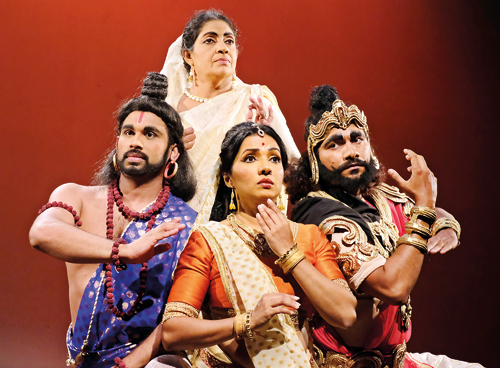Humanity takes centre stage

A scene from Ravana-Sitabhilashaya: A production in the grand manner of Maname and Sinhabahu
If you are hungering for the dimmed footlights and the reverberating drumming that herald the dramatic entrance of Sarachchandra’s Veddah king or the Lion- if you feel jaded with the innuendo and titillation which seem to have become the staple on the boards today- Namel Weeramuni has just the thing for you.
The thespian, for whom the stage has been a sanctuary for over six decades, brings in a novel twist to the most famous of Indian epics, the Ramayan, with his Ravana-Sitabhilashaya. This musical, which borrows from the island traditions of folk theatre, nadagam and noorti, is based on a script by Prof. J. B. Disanayaka.
Namel Weeramuni collaborated on the script with Prof. Disanayaka. The result is a powerful work of theatre which addresses humanity, a classic production in the grand manner of Maname and Sinhabahu.
The epic of Ramayan, over the millennia, has spawned hundreds of interpretations. Ravana’s effigy is still burnt in a vindictive fury, thousands of years strong, by the followers of Rama in India. But rather than bring out a facile, Sri Lankan patriotic rendering of a great and good Ravana, Namel and Prof. Disanayaka have created a play with more depth of human feeling and drama.
The play unrolls from when Sita and Rama enter the Dandaka forest where they should live in exile. The story takes on an entirely novel turn at the point where Rama and Ravana clash over Sita. When Rama makes Sita leap into the fire for agnipariksa to test her purity, Ravana rescues her. Sita promises to be Ravana’s bride only if he could bring her the heart of his mother, thinking this an impossible feat. Yet the queen mother, on hearing this, readily offers her heart.

Namel Weeramuni. Pix by Amila Gamage
What echoes heartrendingly is the depth of a mother’s love. But there are also powerful lessons on humanity and peace and non-conflict embedded within. Namel firmly believes that only art can transform people, and believes audiences should always take something substantial home.
The old tradition of nadagamas- traditional plays with singing- lend all their colour and music to Ravana-Sitabhilashaya. The stylized presentation with songs takes audiences down an atavistic path to the colourful village entertainments at night time when ancient stories were rendered into enthralling spectacles. But in its essence, Namel’s is a modern play, mixing Hindu epic with Jataka story or biblical tale (that regarding the mother’s heart) to concoct a powerful new chronicle with some timeless messages.
The musical features an experienced cast. Surangi Kosala is Sita while Rajitha Hewatantrige is Ravana and Chaminda Mirihagalla, Rama. Nihari Somasiri plays Ravana’s mother. The choreography is by Akila Palipana while the music is by Jayantha Aravinda and Lionel Gunathilake.
The seven piece orchestra is unique in that, apart from the violin and the flute, it includes a mandolin and local percussion items including the yak-bere and the maddale, to bring in the beat of traditional folk theatre.
Ravana-Sitabhilashaya will unravel on the boards at the Namel Malini Punchi Theatre from October 4 – 6. On October 4 and 6 there will be two shows, at 3.30 and 7 p.m., while on October 5 there will be one show at 7 p.m. Tickets are priced at Rs. 2000, 1500, 1000, 750, and 600 for the balcony.


